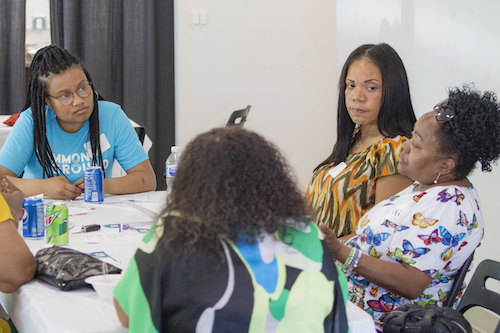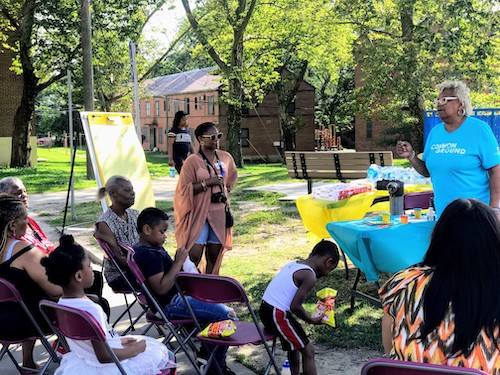By Kimalon Dixon, Senior Project Director, Cleveland Purpose Built Communities & Makela Hayford, Cleveland Foundation 2018-2019 Public Service Fellow
Launched in 1995, Purpose Built Communities is a national model for implementing holistic change in underserved communities. The model is a three-pronged approach to community development that is focused on a high-quality education pipeline, mixed income housing, and community wellness. In 2018, Cleveland’s Glenville and Buckeye-Woodhill neighborhoods were selected to join the roster of communities that make up the Purpose Built Communities network. This work is spearheaded by a partnership between the Cleveland Foundation and Saint Luke’s Foundation.
While the Purpose Built Communities model is groundbreaking and will lead the way in creating lasting change in Glenville and Buckeye-Woodhill, the vison that residents have for their neighborhoods is the most important aspect of the transformation process. This June, community leaders utilized the Common Ground day of community conversation to share a meal, connect with other residents and discuss the brighter future that awaits each neighborhood. Each conversation encouraged residents to answer the following questions:
- What is your dream for your neighborhood?
- What would you like to see for your children, your family, your neighbors…yourself?
- How can we create a community that feels good to call home?
Glenville
 In Glenville, residents began the conversation by reminiscing about the different ways they used to connect with one another; whether it was welcoming new neighbors with a dessert, spending warm evenings chatting on the porch, and line dancing in the street at block parties, Glenville residents reveled in the beauty of engaging with their community. This trip down memory lane led those in attendance to ask the question: how can we bring these memories back to life as the community grows and changes? Residents explored potential answers to this question and concluded that engaging with youth is an essential aspect of moving the community forward. The conversation then turned into an ideation session focused on the authentic ways residents want to engage with young people and get them involved in the visioning process for the community.
In Glenville, residents began the conversation by reminiscing about the different ways they used to connect with one another; whether it was welcoming new neighbors with a dessert, spending warm evenings chatting on the porch, and line dancing in the street at block parties, Glenville residents reveled in the beauty of engaging with their community. This trip down memory lane led those in attendance to ask the question: how can we bring these memories back to life as the community grows and changes? Residents explored potential answers to this question and concluded that engaging with youth is an essential aspect of moving the community forward. The conversation then turned into an ideation session focused on the authentic ways residents want to engage with young people and get them involved in the visioning process for the community.
Buckeye-Woodhill
 In Buckeye, residents envisioned the future of the neighborhood; stability, opportunity, and fun. The ideas came rapid-fire as the designated scribe, Monique, captured them on a flipchart. Residents voiced ideas for quality schools, sports, places to read, and a more accessible transit system to get to destinations across the city. When they broached the topic of education, school choice came up as a pertinent issue. Many of the residents send their children to a school outside of the zoned area for a variety of reasons. The conversation touched on the assets of the Harvey Rice Wraparound School and gave residents the opportunity to discuss possible enhancements.
In Buckeye, residents envisioned the future of the neighborhood; stability, opportunity, and fun. The ideas came rapid-fire as the designated scribe, Monique, captured them on a flipchart. Residents voiced ideas for quality schools, sports, places to read, and a more accessible transit system to get to destinations across the city. When they broached the topic of education, school choice came up as a pertinent issue. Many of the residents send their children to a school outside of the zoned area for a variety of reasons. The conversation touched on the assets of the Harvey Rice Wraparound School and gave residents the opportunity to discuss possible enhancements.
The Impact of the Conversation and Beyond
The conversations sparked new ideas while acknowledging that residents in both communities have felt excluded from their own neighborhoods – places where many have lived for generations. Speaking this truth created a space of authenticity and a pathway for everyone to move forward, together. Within the two-hour conversations, everyone in the room had established new connections, and you guessed it—common ground.
Common Ground was a wonderful opportunity to authentically connect with community members and learn about their desires and concerns about their neighborhoods. I was energized listening to community members share their ideas about how we may work together to improve the quality of life in our city.
The Common Ground conversations created a safe space for true thoughts and lived experiences to be shared. The conversations were very fruitful, and residents hope to have more authentic opportunities like Common Ground to connect with each other and those invested in improving their neighborhoods. With Purpose Built Communities, residents will have many more opportunities to do just that.



